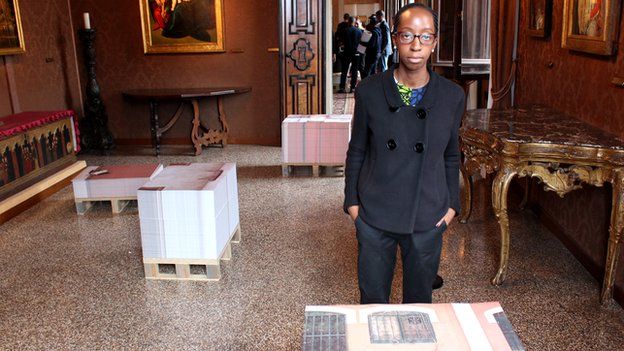Africa triumphs at the Venice Biennale
- Published

The long queues in front of Angola's pavilion at the Venice Biennale bear witness to the extraordinary success that Africa has just had at the "Olympics of the art world".
Ever since it was announced that, out of 88 contenders, Angola had won the Golden Lion award for the best national participation, art lovers and journalists from all over the world have been flocking across the Accademia bridge - from the distant main exhibition areas, the Giardini and the Arsenale - to try to see the show.
Many have left Venice without being able to do so.
The centrepiece of the pavilion - located in a 16th-century building, the Palazzo Cini - is a series of 23 posters, which visitors can take home, with images of objects that photographer Edson Chagas found in the streets of Luanda.
"I waited an hour and a half to get in. After they won the Venice Biennale everyone wanted to see Angola, and it was very much worth the wait," Callum Schuster, 24, from Toronto, Canada, told BBC Africa.
"Inside this beautiful building, [with] very decorative, ornate structures, porcelain, paintings, everything you can imagine inside your typical Venetian palace, they have wooden skids [palettes] filled with posters, cheap paper posters with derelict objects and scenery from the street," he said.
"Amongst this beautiful interior you see people going crazy, just tearing up the paper; they want to collect these limited edition prints, these photographs from this famous artist who won the Venice Biennale."
The Angolan show was curated by architects Paula Nascimento and Stefano Rabolli Pansera.
"We work a lot on issues of urbanism, territory, space and habitation within the city, and we found in the work of Edson Chagas a link through these issues because what Edson does, for us, is not simply an act of documentation but it's an act of creation and invention," Ms Nascimento said.
The photographer told the BBC that when he finds discarded objects that interest him, he carries them around the city, like performance art.
"I grab the objects and then I find the place that it's suitable for them to be photographed nicely, giving kind of some importance to them, so they become a piece of art," Mr Chagas said.
"The idea for the pavilion was to make this performance come inside the pavilion so people could engage with the pictures the same way I was engaging with the objects in the street."
'Viva Africa'
Angola's triumph has been celebrated across Venice by the other participating African nations.
"The excitement to me is overwhelming because it's very important. Angola, this is their first participation and they've done it, and they've done Africa proud… And if we're celebrating 50 years after the formation of the OAU (Organization of African Union) with a Golden Lion, it's viva Africa," the curator of the Zimbabwe pavilion, Raphael Chikukwa, said.
"This year is amazing because in the last Venice Biennale we were two African countries - South Africa and Zimbabwe - and now we've been joined by Ivory Coast, Angola and Kenya. The visibility of African countries this year has increased," he pointed out.
Zimbabwe is showcasing the work of five artists - Portia Zvavahera, Voti Thebe, Rashid Jogee, Virginia Chihota and Michele Mathison.
South Africa has a much bigger group of artists reflecting on how archival research is affecting contemporary art in the country.
One of them, Sam Nhlengethwa, is presenting a series of photolithographs which look at apartheid infrastructure during the 1950s and 1960s.
"There are images, I'd say predominantly about the suffering of South African blacks during that period but I was also highlighting the style of fashion that our parents and grandparents used to wear," the artist explained.
The Ivory Coast pavilion, put together by one of West Africa's leading intellectuals - art critic and philosophy professor Yacouba Konate - displays works by Jem's Robert Koko Bi, Tamsir Dia, Franc Fanny, and Frederic Bruly Bouabre, who is also included prominently in the main international exhibition, called The Encyclopedic Palace, next to a series of tapestries by Senegal's Papa Ibra Tall and not far from the amazing photographs by Nigerian master J.D. 'Okhai Ojeikere.
"The participation of countries like Ivory Coast, Zimbabwe or Kenya is a way to make the so-called Encyclopedia more complete because in the past several Encyclopedic projects let Africa down," Mr Konate told the BBC.
"Now I think it is not possible to pretend any more to write an encyclopaedia without including Africa, South America or Asia."
China and Africa
One of the main themes of this year's biennale is artistic collaboration across borders and disciplines.
However, it was still strange to see so many Chinese artists in the Kenyan pavilion.
The Italian-curated show displays the works of eight artists from China, one Italian, one Italo-Brazilian and only two Kenyans.
Critics say the works themselves are stereotypical: Primitive-looking African paintings by Kenyan Mbuno Kivuthi and "tribal" sculptures by Italian Armando Tanzini in a small room; hi-tech digital works by several Chinese artists in a much bigger one.
According to Zimbabwe's curator, Raphael Chikukwa, none of his Kenyan colleagues had even heard about the show.
"When we saw it here it was a bit of a shock... Yes, there might be a spirit of collaboration but it has to be genuine," he said.
One of the members of this year's biennale's jury, Nigerian curator and artistic director of the Centre for Contemporary Art, Lagos, Bisi Silva, agreed that the large Chinese presence was "peculiar".
"But then, you know, the theme is collaboration, it's about exchange," she said.
"We all know that the Chinese are in Africa and they're quite prominently there, so maybe this is a reflection of what is actually happening on the continent."
- Published4 June 2013
- Published30 May 2013
- Published28 May 2013
- Published29 May 2013